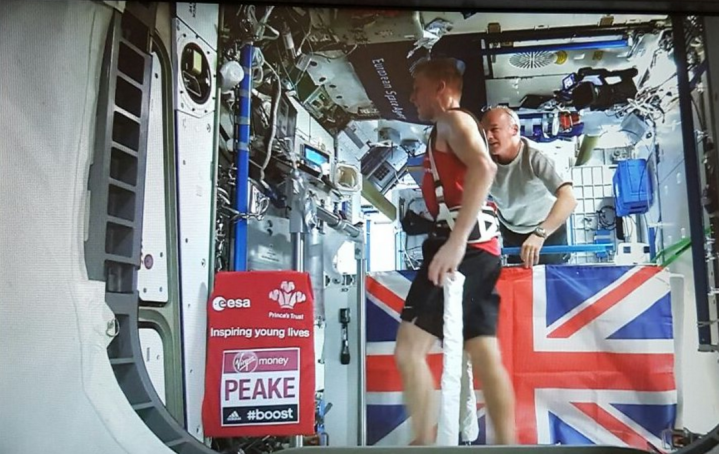
Following through on a promise he made back in December shortly before arriving on the International Space Station, Peake donned his running gear and hopped aboard a treadmill to run the race virtually, and even provided the countdown to the start of the event for the 40,000 or so runners back on the ground in the UK capital.
Thanks to the first-person view of the route offered by the RunSocial mixed-reality app, as well as live video and audio feeds of the 26.2-mile (42.2 km) race, the space-based marathon runner was able to feel like he was really there – so long as he could ignore the complex harness system that was keeping him tethered to the treadmill.
That’s right, the small matter of gravity (or lack of it) meant Peake needed a way of making sure he could actually put one foot in front of the other to complete the course.
“One of the biggest challenges is the harness system,” he told the BBC before the race. “Obviously, my bodyweight has to be firmly attached to the treadmill by this harness, and that can rub on the shoulders and around the waist.” Indeed, chafing can be a serious challenge for any long-distance runner, but it sounds like Peake needed an extra tube or two of space-friendly lubricant to see him safely to the finishing line.
42 km, while @Space_Station flew almost 100000 km. Congratulations to everyone in #LondonMarathon & #teamastronaut…gonna sleep well tonight!
— Tim Peake (@astro_timpeake) April 24, 2016
The British astronaut, who arrived on the ISS on December 15 for a six-month stay, completed the London Marathon in 3:35:21, a little slower than when he ran the same course in 1999 – on terra firma – clocking 3:18:50.
The RunSocial app helped Peake feel a part of the events on the ground, offering him a high-definition POV recording of the actual course. A particularly cool feature meant the visuals matched the speed at which Peake ran, with VR avatars of others using the app appearing around him as he proceeded along the course.
The astronaut even managed to break the world record for a marathon run in space. What? You mean someone else has already run a marathon in space? Yes, indeed. In 2007, Sunita Williams ran the Boston Marathon aboard the ISS, finishing in just under four and a half hours.


